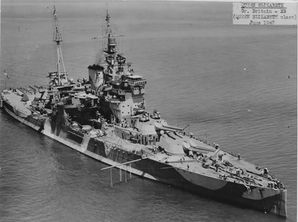
The beginning of the battleships Queen Elizabeth part 2
Queen Elizabeth, probably after the end of the First World War. On tower B is the launch pad for the aircraft. Editorial photo archive
There were a number of compromises in the version of the ship approved for construction. This, in principle, can be said about every ship, because you always had to give up something in order to acquire something else. However, in the case of Queen Elizabeth's superdreadnoughts, these compromises were much more obvious. Came out relatively better...
..main artillery
As it soon became clear, the risk of creating completely new 15-inch guns was justified. The new artillery proved to be extremely reliable and accurate. This was achieved through the use of proven solutions and the rejection of over-performance. The barrel was relatively heavy despite the relatively short length of 42 calibers.
Cannon design is sometimes criticized for being "conservative". The inside of the barrel was additionally wrapped with a layer of wire. This practice was used en masse only by the British and those who learned from them. Apparently, this feature was supposed to indicate obsolescence. The guns, which were assembled from several layers of pipes, without any additional wire, were supposed to be more modern.
In essence, this is the same as the "invention" of the all-or-nothing armor scheme in the United States at the turn of the XNUMXth century, while in the world it was applied almost half a century earlier.
In the Middle Ages, guns were cast from a single piece of metal. With the development of metallurgy, at some point it became possible to precisely manufacture large-diameter thick-walled pipes. Then it was noticed that the dense assembly of several pipes on top of each other gives a design with a much higher tensile strength than in the case of a single casting of the same shape and weight. This technique was quickly adapted to the production of barrels. Some time later, after the invention of folding cannons from several layers, someone came up with the idea of wrapping the inner tube with an additional layer of highly stretched wire. High-strength steel wire squeezed the inner tube. During the shot, the pressure of the gases ejecting the rocket acted in the exact opposite direction. The stretched wire balanced this force, taking some of the energy onto itself. Barrels without this reinforcement had to rely solely on the strength of subsequent layers.
Initially, the use of wire allowed the production of lighter cannons. Over time, the matter ceased to be so obvious. The wire increased the tensile strength of the structure, but did not improve the longitudinal strength. Barrel,
necessarily supported in one place close to the breech, it sagged under its own weight, causing its exit port not to be in line with the breech. The greater the bend, the greater the likelihood of vibration during firing, which translates into different, completely random values of the rise of the muzzle of the gun relative to the surface of the Earth, which in turn translated into accuracy. The greater the difference in elevation angles, the greater the difference in the range of projectiles. In terms of reducing barrel sag and the associated vibration, there seems to be no wire layer. This was one of the arguments against abandoning this excess weight gain from the gun design. It was better to use a different tube, which was applied outside, which not only increased the tensile strength, but also reduced the bending. According to the philosophy of some navies, this was true. However, the British had their own specific requirements.
The heavy artillery of the Royal Navy had to be able to fire even if the inner layer was torn or part of the thread was torn off. In terms of the strength of the entire barrel, even removing the entire interior made little difference. The barrel had to be able to fire without the risk of tearing it apart. It was on this inner layer that the wire was wound. In this case, the lack of an increase in longitudinal strength meant nothing, since it was all designed in such a way that it was not affected by the inner layer! In addition, compared to other countries, the British had much stricter security requirements. Guns were designed with a larger margin than anywhere else. All this added to their weight. With the same requirements, the removal (i.e., resignation - ed.) of the wound wire did not mean savings in weight. Most likely quite the opposite.
